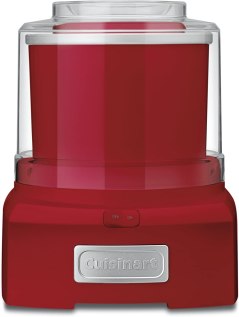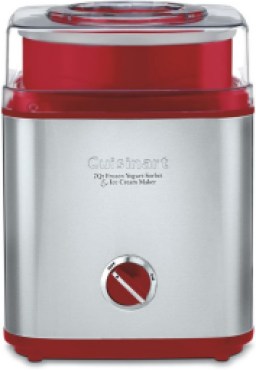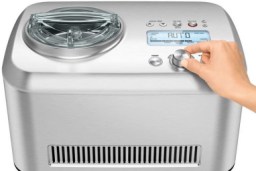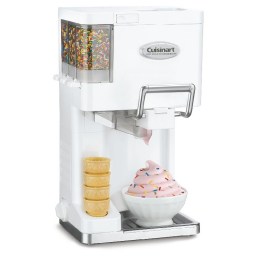Buying guide for best ice cream makers
Ice cream makers are fun to use and great for kids’ parties, family gatherings and other get-togethers. Making your own ice cream lets you create flavors and combinations that are limited only by your imagination, without preservatives, additives or artificial ingredients.
Making ice cream at home used to entail a bucket of ice, a box of salt, lots of elbow grease and plenty of time. Fortunately, ice cream makers no longer require that kind of effort. You can find machines that use a prefrozen bowl or devices that freeze the mixture as they work. Many stand mixers have an optional ice cream maker attachment. Even ice cream makers that still use ice and salt now have motors to do the churning for you.
We researched ice cream makers and put some popular models to the test in the BestReviews Testing Lab. Based on our findings, we recommend the innovative online favorite Ninja Creami Ice Cream Maker as the fastest and most versatile one you can find.
Expert Tip
Fat is flavor! Substituting lower-fat options, especially without adjusting other ingredients, reduces the flavor and can alter the texture. Less fat = more water = harder ice cream. This is why store-bought ice creams are so hard – they use a lot of water instead of dairy to reduce cost.
BestReviews Cooking and Baking Expert
Best ice cream makers
Ninja’s entry into ice cream makers, the Creami, is widely popular on social media, and we can see why. We can’t think of another kitchen appliance we’ve tested that can accomplish what the Creami does as simply and quickly. Rather than a liquid mix churned slowly for up to half an hour as with other ice cream makers, the Creami starts with a frozen mix that a powerful paddle churns and whips. We made a frozen base with fruit, water and a little coconut milk, and the Creami turned out a delicious sorbet in a few minutes. The device has seven presets for speed and hardness, including ice cream and sorbet as well as milkshakes and smoothie bowls. As a convenience, the paddle, bowls and lids are all dishwasher safe.
Cuisinart has a range of well-regarded ice cream makers of different sizes and capabilities, and the Cuisinart ICE-21 represents the best bang for your buck. It’s easy to use, it consistently produces great results and it is affordably priced. To use the ICE-21, you must freeze its bowl for 16 to 24 hours before use. The fully automated process takes less than 20 minutes to churn 1.5 quarts of fresh ice cream. And it’s easy to add flavorings and extras through the wide spout on the clear lid. This model comes in three colors too. About the only drawback to the ICE-21 is that the bowl takes up space in the freezer, but that is true of all ice cream makers of this type.
The Cuisinart ICE-30 is the larger sibling of the ICE-21, with a 2-quart bowl for making half a gallon of ice cream or frozen yogurt at a time. We like its larger capacity combined with the simple operation and large mix-in spout, similar to that on the ICE-21. In our tests, we found that freezing the bowl for at least 24 hours produces the best texture, and freezing it for less time produces very soft ice cream. We tested various recipes, including plain vanilla, cookies and cream, blueberry sorbet and vegan ice cream with coconut milk, all with excellent results. The ICE-30 has a simple on/off dial in front, most of the parts are dishwasher safe and the brushed metal finish looks good on the kitchen counter.
The Smart Scoop is a compressor-type ice cream maker, which means you don’t need ice and you don’t have to freeze the bowl before you begin. The compressor chills and freezes your homemade ice cream while it churns, so you can make a batch with a lot less prep time. The Breville boasts 12 individual hardness settings, so you can make not only ice cream and sorbet but also smoother, denser, lower-fat gelato. The Breville is completely automated, with an alert tone that lets you know your mix is ready. Thanks to the compressor, it can also keep your ice cream cold for up to three hours.
If you’re one of the many home cooks who has an iconic KitchenAid stand mixer, you can make ice cream with this attachment that fits nearly all of Kitchenaid’s Tilt-Head and Bowl-Lift stand mixers. This ice cream maker consists of a 2-quart freezer bowl with a dasher and adapter for the mixer. The freezer bowl must be frozen for 24 hours for the best results. Like other freezer bowl ice cream makers, this one takes about 30 minutes to produce ice cream. All three components are designed for quick installation and easy use and can be cleaned in warm water.
Another of our favorite compressor-type ice cream makers, and endorsed by Andrea Boudewijn, our cooking and baking expert, is this 2.1-quart model from Whynter. It has a smaller footprint than the Breville, making it a better fit for a small or crowded kitchen counter, although it’s a few inches taller. We particularly like the flexibility of this model. You can set it to freeze only or churn only, as well as make ice cream automatically. With the various settings, it can make smooth gelato or refreshing sorbet as easy as ice cream or frozen yogurt, and it can keep the contents cold after churning is complete.
The old ice-and-salt method of making ice cream at home has never really gone away, especially since it’s one of the most efficient ways to make a large batch. The Hamilton Beach ice cream maker uses ice and rock salt to make up to a gallon of fresh ice cream, but don’t worry — you don’t have to crank it by hand. The powerful motor and paddle take care of the churning for you. It’s easy to add flavorings and mix-ins, and the straightforward design means you don’t have to pre-freeze a bowl or any ingredients. Just have enough ice and salt handy, and you’re good to go.
Expert Tip
Washing out an ice-cold freezer bowl after use can be tricky. Soapy dishwater can freeze instantly on the inside or, worse, your wet fingers can freeze to the side of the cold bowl. For best results, use only room temperature or slightly warm water to continuously melt the freezing water and creamy mess. When done, quickly flip the bowl upside down on a dishtowel to thaw and dry.
BestReviews Cooking and Baking Expert
How we tested
After researching ice cream makers, we tested the Ninja Creami and Cuisinart Pure Indulgence to see how they performed.
Setup and design
- Unpacking and assembly: We set up each machine according to the instructions to see how easy or difficult the process was.
- Size and design: We measured the size of each machine to see how it fit on a kitchen counter and stored in a kitchen cabinet, how easy or difficult it was to move and lift, and for pre-freeze models, how much space the bowl or jar took up in the freezer.
Usage
- Ease of use: We took note of how easy the machines were to operate, how many settings they had and any quirks while operating.
- Speed: We timed how long it took to make ice cream, including the time needed for freezing or cooling the bowls or ingredients beforehand.
- Mix-ins: We judged how easy or difficult it was to add mix-ins, such as fruit, cookies or nuts to the ice cream, and if we could do it while the machine was operating.
- Cleanup: We noted which parts, if any, were machine washable, needed hand-washing or required any special handling.
Results
- Quality: We tasted the resulting frozen treats for flavor and texture; including texture out of the machine and after freezing, as well as ease of scooping and distribution of any mix-ins.
- Versatility: We made basic vanilla ice cream, vegan ice cream, vegan sherbet and sorbet to judge how well each machine adjusted to various ingredients and texture requirements.
What to know before you buy an ice cream maker
Type
There are three basic types of ice cream makers for use at home, plus a few specialty types.
Traditional: This is the old-fashioned ice cream maker you might remember from childhood. It consists of a bucket you fill with a mixture of rock salt and ice, which acts as a refrigerant to freeze the ice cream while you work. A container inside the bucket of ice holds the ice cream ingredients. Traditional machines crank out a large quantity of ice cream, often a gallon or more at a time, making one a good choice for a large family or group. No components need to be frozen ahead of time. This is the least expensive type of ice cream maker.
However, you do need to have plenty of rock salt and ice on hand, and this type of machine can be messy. Also, cranking a manual machine can be tiring!
Frozen bowl: This type of ice cream maker is the most popular thanks to its affordability and ease of use. After freezing the empty ingredient bowl overnight, you add your ingredients and place the bowl in the machine. The machine churns the ingredients until the ice cream is ready. There is no fussing with rock salt and ice, no cranking by hand and no mess to contend with. Very little cleanup is required with this type of machine.
One downside is that you need to freeze the bowl in advance. These machines also don’t make a lot of ice cream per session, usually 2 quarts or less. You also can’t make ice cream on a whim. You need to freeze the bowl in advance, usually overnight. You can solve this problem by storing the bowl in the freezer between uses, but this takes up quite a bit of space.
Compressor: These ice cream makers have their own built-in freezer, so there’s no need to pre-freeze any of the components. Just add your ingredients, flip the switch and the machine takes care of the rest. Compressor ice cream makers keep the ingredients consistently cold throughout the entire process, so they tend to produce the creamiest results with the least risk of ice crystals or coarse texture. These machines generally have features like a digital countdown timer, a “keep cool” function and various settings for different types of frozen desserts, such as sorbet, frozen yogurt and gelato.
On the downside, these machines take up a lot of storage or counter space and are significantly more expensive than other types of ice cream makers.
Other: Aside from the Kitchenaid stand mixer attachment and the Ninja Creami, you can find other gadgets for making ice cream, such as small balls in which you manually churn the mix, or frozen trays with paddles that allow you to mix and fold ice cream in sheets like in ice cream parlors.
Expert Tip
Do your research: Some freezer-bowl models offer a second freezer bowl in the package. A second bowl allows you to make a lot of one flavor or to make two different flavors without having to wash and re-freeze a bowl.
BestReviews Cooking and Baking Expert
Tips
- Don’t overfill the machine. If the machine is too full, the ice cream is likely to overflow. A good rule of thumb is to keep the bowl no more than two-thirds full.
- Take your time. Ice cream mix needs to be cold before it’s churned. For the best results, refrigerate the mix overnight.
- Use high-quality ingredients. The best ice cream is made with fresh, high-quality ingredients. Use cream, not milk. Choose real vanilla and other flavorings, not imitation flavors.
- Don’t worry about calories. Fat, and plenty of it, is what gives ice cream its creamy mouthfeel. Avoid low-fat ingredients unless you’re making sorbet. Use pure cream or, for vegan ice creams, coconut milk.
- Start mixing the ingredients as soon as they’re in the bowl. Otherwise, large, coarse ice crystals can form, which will affect the consistency of your ice cream.
- Let ice cream sit before serving. For the best texture, let frozen ice cream sit at room temperature for a few minutes before serving. Use a wet spoon or scoop, not a warm one, to serve.
- Store ice cream in shallow, wide containers. These are better than tall, narrow containers because they cool the ice cream quickly, avoiding big ice crystals. They also allow you to make longer, prettier scoops.
- Add mix-ins at the end of the process. If you want mix-ins such as cookies, brownies and candy to retain their shape or texture, add them at the end.
Recipe for vanilla ice cream
Here’s how to make a basic yet flavorful vanilla ice cream at home.
Ingredients:
- 1 cup heavy whipping cream
- 2 1/4 cups whole milk
- 3/4 cup white sugar
- 2 teaspoons real vanilla extract
Directions:
- Heat the cream, milk and sugar in a small saucepan until the sugar dissolves and the mixture is hot. Don’t let the ingredients boil.
- Pour the mixture into a storage container and stir in the vanilla extract.
- Let the mixture cool until it is just warm. Refrigerate the mixture overnight.
- Pour the mixture into the ice cream maker and follow the machine’s standard procedure.
- Let the ice cream chill in the freezer for a couple hours and enjoy.
FAQ
Q. How much do ice cream makers cost?
A. The price of ice cream makers ranges from as low as $40 to as high as $700 for high-end gourmet machines. Freezer-bowl types usually cost between $40 and $150. Manual or electric ice-and-salt churners cost around $50 to $60. Compressor machines cost $250 and up.
Q. What’s the difference between ice cream and gelato?
A. Ice cream is usually made of a mixture of cream, milk, and sugar, and may contain eggs or egg yolks (also known as frozen custard). Gelato, often known as Italian ice cream, is made only with milk and sugar. It has less air churned into it than ice cream and has a stronger flavor. Since it isn’t typically made with cream, it tends to have less fat and fewer calories than regular ice cream.
Q. Is homemade ice cream as good as store-bought ice cream?
A. Homemade ice cream has fewer ingredients and no additives like fillers or stabilizers unless you put them in. Homemade ice cream has a softer, creamier texture out of the machine that you can make firmer to your preference. You control the recipe of your homemade ice cream, allowing you to experiment with ingredients and combinations that major ice cream manufacturers don’t have.
However, if you have a specific flavor and brand of store-bought ice cream you love, you may have trouble recreating it at home. Because it contains no preservatives, homemade ice cream also doesn’t last as long as store-bought ice cream. It can last up to two weeks in the freezer with optimum flavor and texture, but you might notice excessive ice or difficulty scooping and other texture problems after a week. Homemade ice cream is best served soon after it’s made.
Q. Why is homemade ice cream so hard?
A. Homemade ice cream tends to freeze harder than store-bought ice cream because it is denser, containing no stabilizers like carrageenan and less fat and sugar. The more air churned into ice cream, the softer and fluffier it is, and since fat doesn’t freeze, a higher fat content will also produce a softer texture. To soften hard homemade ice cream, let it soften for several minutes in the refrigerator before scooping.

































